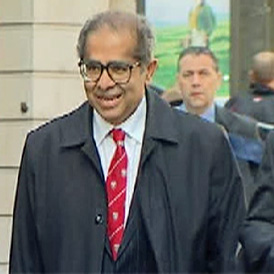Patel: G20 death natural causes not internal bleeding
Dr Freddie Patel, the under fire pathologist of the G20 death, continued to insist that Ian Tomlinson died of natural causes despite two other reports claiming it was due to internal bleeding.

The pathologist who conducted the post-mortem on Ian Tomlinson, who died at the G20 protests, has continued to insist to an inquest that the cause of death was related to Mr Tomlinson’s coronary heart disease and not internal bleeding from being pushed to the ground.
At the inquest at the International Dispute Resolution Centre in Fleet Street, London, Dr Freddie Patel was questioned over how he had ruled out internal bleeding as a cause of death and decided that Ian Tomlinson had died of natural causes.
He said: “partly that diagnosis is made on the basis there is no alternate explanation at the time of my examination to explain death.”
Dr Patel added: “There was no major injury to any organs or blood vessels that could produce in a short period of time sufficient bleeding to cause death.”
In his second day of questioning, Mr Patel did admit there was a “compelling” association between trauma and a heart attack. However, he insisted that there was no “causal evidence” that Mr Tomlinson suffered a heart attack triggered by his “stressful” altercation with PC Simon Harwood.
The pathologist, who conducted the original post-mortem of Ian Tomlinson who died during the G20 protests, also admitted to the inquest that he revised his post-mortem report after other experts questioned his findings.
The revision was a change in wording detailing that a large amount of blood in Tomlinson’s stomach was not pure blood. The changes were made a year after the original report following two separate pathologists who had concluded that the cause of death was in fact internal bleeding. Dr Patel’s findings, now widely known, stated that the newspaper salesman had died of natural causes and excused his alterations so long after his initial findings: “The issue arose on the cause of death and it appeared to me that other experts have misinterpreted what I was trying to convey in my report”.
Dr Patel claimed that he changed the details of the report because he wanted to make it clear that what was present in Tomlinson’s abdoman was not pure blood, “it was ascites [excess] fluid with some blood in it.”
Expert analysis, background info and interactive video timeline available at the Ian Tomlinson inquest: Special Report
The inquest heard on Tuesday that evidence potentially vital to determining the difference in the contrasting conclusions of the pathologists had been discarded from the mortuary. The contents of Ian Tomlinson’s stomach went missing from the mortuary. Dr Patel told the inquest: “I didn’t see it being discarded but then when the issue arose about the cause of death, I went back to the mortuary to ask where is that sample, and it wasn’t in the mortuary. So it can only mean it was discarded.”
Tomlinson was five times over drink driving limit
Further evidence at the inquest centred around the levels of alcohol within Ian Tomlinson’s blood on the day of his death. Tests showed he had five times the legal driving limit of alcohol in his system and Patel told the audience at the inquest that this could explain why he did not complain of any pain after the incident:
“If he had sustained a rib fracture as a result of a fall, you would expect him to either put a hand where the injury is or say, ‘I’ve hurt myself’ in that region”
He added: “What is confounding is that he has a very high alcohol level and there is a possibility that might have numbed or dulled his perception of pain.”
The jury were also reminded that Dr Patel has been sanctioned by the General Medical Council twice for failings in post-mortem exhaminations, serving a three month ban from practice in 2010 and currently serving a four month ban.